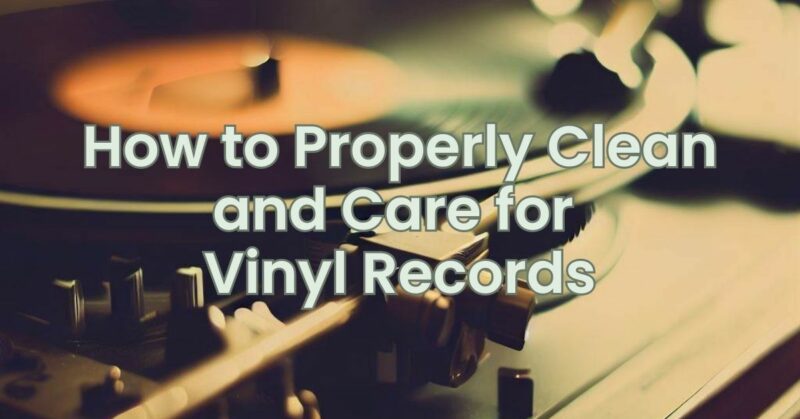Vinyl records are cherished for their warm sound and nostalgic appeal. To preserve their quality and extend their lifespan, it’s essential to clean and care for them properly. Dust, dirt, and fingerprints can accumulate on the surface of vinyl records, affecting sound quality and causing unnecessary wear on the stylus. In this article, we will guide you through the process of properly cleaning and caring for your vinyl records, ensuring optimal playback and enjoyment for years to come.
- Precautions Before Cleaning: Before diving into the cleaning process, keep the following precautions in mind
a. Handle records with clean hands: Wash your hands thoroughly or use lint-free gloves to handle vinyl records. Oils, dirt, and debris from your fingers can transfer to the record surface and affect playback.
b. Keep records in protective sleeves: Always store your records in protective inner sleeves to prevent dust, scratches, and static buildup.
c. Store records upright: Store your records vertically in a sturdy record storage unit or shelf to prevent warping or damage.
- Dry Cleaning: Dry cleaning helps remove surface dust and debris from vinyl records. Follow these steps
a. Use a carbon fiber brush: Gently brush the surface of the record in a circular motion using a carbon fiber brush. This removes loose particles and static electricity.
b. Remove excess debris: Use a stylus brush to clean the stylus. Gently brush the stylus from back to front to remove any accumulated dust or debris.
c. Clean outer record jacket: Wipe the outer jacket with a microfiber cloth to remove any dust or fingerprints.
- Wet Cleaning: Wet cleaning is necessary for deep cleaning and removing stubborn dirt and grime. Follow these steps
a. Create a cleaning solution: Mix a small amount of gentle record cleaning solution with distilled water in a spray bottle. Avoid using tap water, as it may contain minerals that can leave a residue.
b. Apply the cleaning solution: Lightly spray the cleaning solution onto a soft, lint-free record cleaning cloth or microfiber cloth. Avoid oversaturating the cloth.
c. Clean the record: Place the record on a clean, flat surface. Gently wipe the record surface in a circular motion with the damp cloth, following the grooves. Be careful not to apply excessive pressure.
d. Rinse and dry: After cleaning, rinse the record with distilled water to remove any residue. Then, use a separate dry cloth to gently pat the record dry or let it air dry in a vertical position.
- Deeper Cleaning Options: For more intensive cleaning, you can consider using a record cleaning machine or a vinyl record cleaning kit, which typically includes a cleaning solution, a brush, and a drying rack. Follow the instructions provided with the cleaning equipment for best results.
- Avoiding Common Mistakes: To ensure the longevity of your vinyl records, avoid the following mistakes
a. Do not use abrasive materials: Avoid using rough cloths, paper towels, or tissues that can scratch the record surface.
b. Do not stack records without protective sleeves: Stacking records without protective inner sleeves can lead to scratches and scuffs.
c. Avoid extreme temperatures and humidity: Store your records in a cool, dry environment away from direct sunlight and extreme temperature fluctuations.
d. Handle records by the edges: Always handle records by the edges to prevent fingerprints and smudges on the playing surface.
Properly cleaning and caring for your vinyl records is essential for maintaining their sound quality and preserving their condition. By following these guidelines, you can remove dust and dirt from the surface, reduce static, and ensure a clean playback experience. Regular cleaning and safe handling practices will help protect your vinyl collection, allowing you to enjoy the rich sound and nostalgic pleasure that vinyl records offer.


